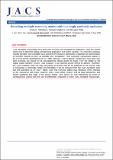Files in this item
Encoding multiple reactivity modes within a single synthetic replicator
Item metadata
| dc.contributor.author | Robertson, Craig C. | |
| dc.contributor.author | Kosikova, Tamara | |
| dc.contributor.author | Philp, Douglas | |
| dc.date.accessioned | 2021-05-14T23:47:32Z | |
| dc.date.available | 2021-05-14T23:47:32Z | |
| dc.date.issued | 2020-06-24 | |
| dc.identifier | 268098090 | |
| dc.identifier | 2fb7a3ce-d75f-4139-b9d2-e8156bcdd1e1 | |
| dc.identifier | 000543780500031 | |
| dc.identifier | 85086977922 | |
| dc.identifier.citation | Robertson , C C , Kosikova , T & Philp , D 2020 , ' Encoding multiple reactivity modes within a single synthetic replicator ' , Journal of the American Chemical Society , vol. 142 , no. 25 , pp. 11139–11152 . https://doi.org/10.1021/jacs.0c03527 | en |
| dc.identifier.issn | 0002-7863 | |
| dc.identifier.other | RIS: urn:7A65B4A69C2D1EABAAAC3944BAFE9FBD | |
| dc.identifier.other | ORCID: /0000-0002-9198-4302/work/74510420 | |
| dc.identifier.uri | https://hdl.handle.net/10023/23194 | |
| dc.description | Financial support for this work was provided by the University of St Andrews and EaStCHEM, Northwestern University, and the Engineering and Physical Sciences Research Council (Grant EP/K503162/1). | en |
| dc.description.abstract | Establishing instructable and self-sustaining replication networks in pools of chemical reagents is a key challenge in systems chemistry. Self-replicating templates are formed from two constituent components with complementary recognition and reactive sites via a slow bimolecular pathway and a fast template-directed pathway. Here, we re-engineer one of the components of a synthetic replicator to encode an additional recognition function, permitting the assembly of a binary complex between the components that mediates replicator formation through a template-independent pathway, which achieves maximum rate acceleration at early time points in the replication process. The complementarity between recognition sites creates a key conformational equilibrium between the catalytically inert product, formed via the template-independent pathway, and the catalytically active replicator that mediates the template-directed pathway. Consequently, the rapid formation of the catalytically inert isomer “kickstarts” replication through the template-directed pathway. Through kinetic analyses, we demonstrate that the presence of the two recognition-mediated reactivity modes results in enhanced template formation in comparison to systems capable of exploiting only a single recognition-mediated pathway. Finally, kinetic simulations reveal that the conformational equilibrium and both the relative and absolute efficiencies of the recognition-mediated pathways affect the extent to which self-replicating systems can benefit from this additional template-independent reactivity mode. These results allow us to formulate the rules that govern the coupling of replication processes to alternative recognition-mediated reactivity modes. The interplay between template-directed and template-independent pathways for replicator formation has significant relevance to ongoing efforts to design instructable and adaptable replicator networks. | |
| dc.format.extent | 3555454 | |
| dc.language.iso | eng | |
| dc.relation.ispartof | Journal of the American Chemical Society | en |
| dc.subject | QD Chemistry | en |
| dc.subject | DAS | en |
| dc.subject | BDC | en |
| dc.subject | R2C | en |
| dc.subject.lcc | QD | en |
| dc.title | Encoding multiple reactivity modes within a single synthetic replicator | en |
| dc.type | Journal article | en |
| dc.contributor.institution | University of St Andrews. School of Chemistry | en |
| dc.contributor.institution | University of St Andrews. EaSTCHEM | en |
| dc.contributor.institution | University of St Andrews. Biomedical Sciences Research Complex | en |
| dc.identifier.doi | https://doi.org/10.1021/jacs.0c03527 | |
| dc.description.status | Peer reviewed | en |
| dc.date.embargoedUntil | 2021-05-15 | |
| dc.identifier.url | https://pubs.acs.org/doi/10.1021/jacs.0c03527?goto=supporting-info | en |
This item appears in the following Collection(s)
Items in the St Andrews Research Repository are protected by copyright, with all rights reserved, unless otherwise indicated.

